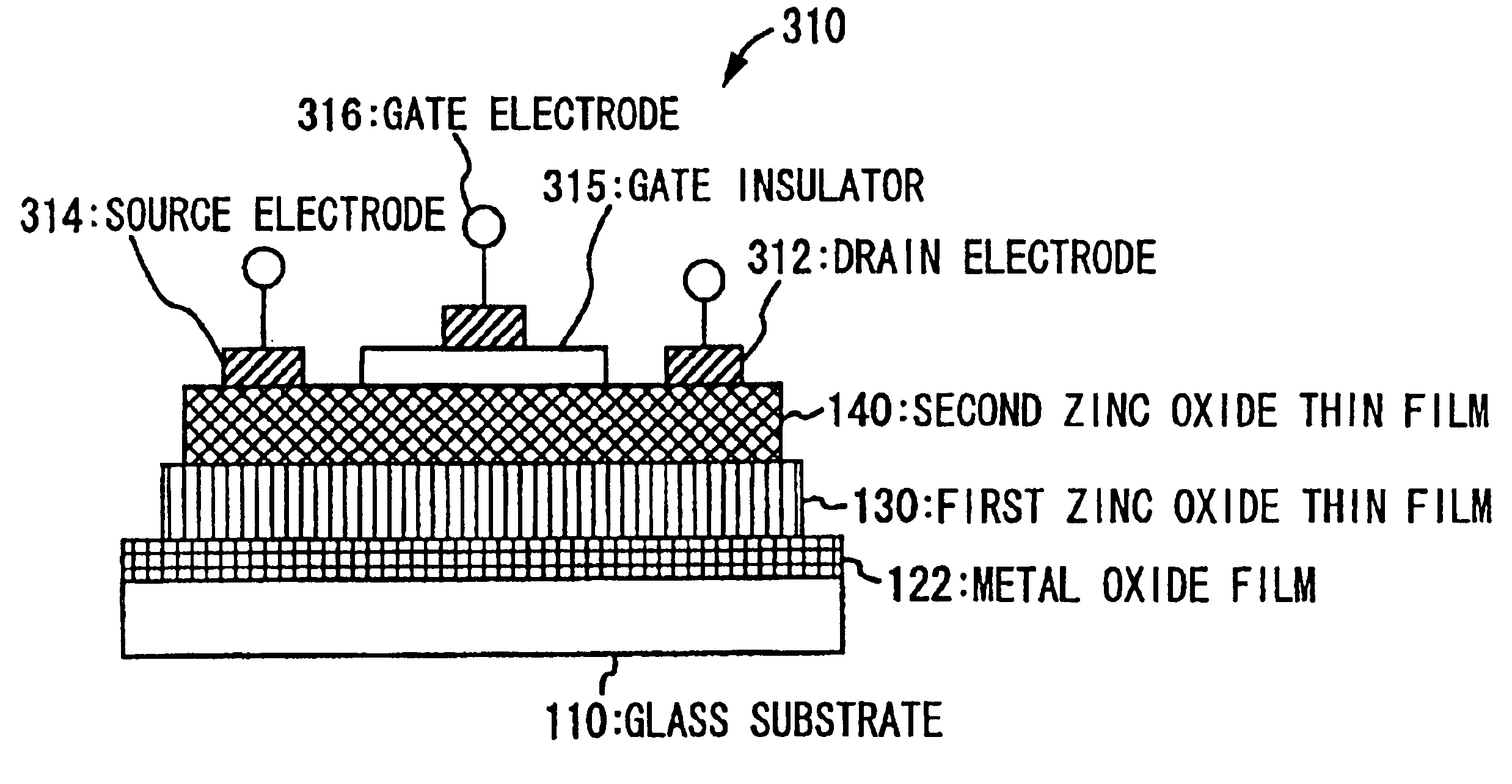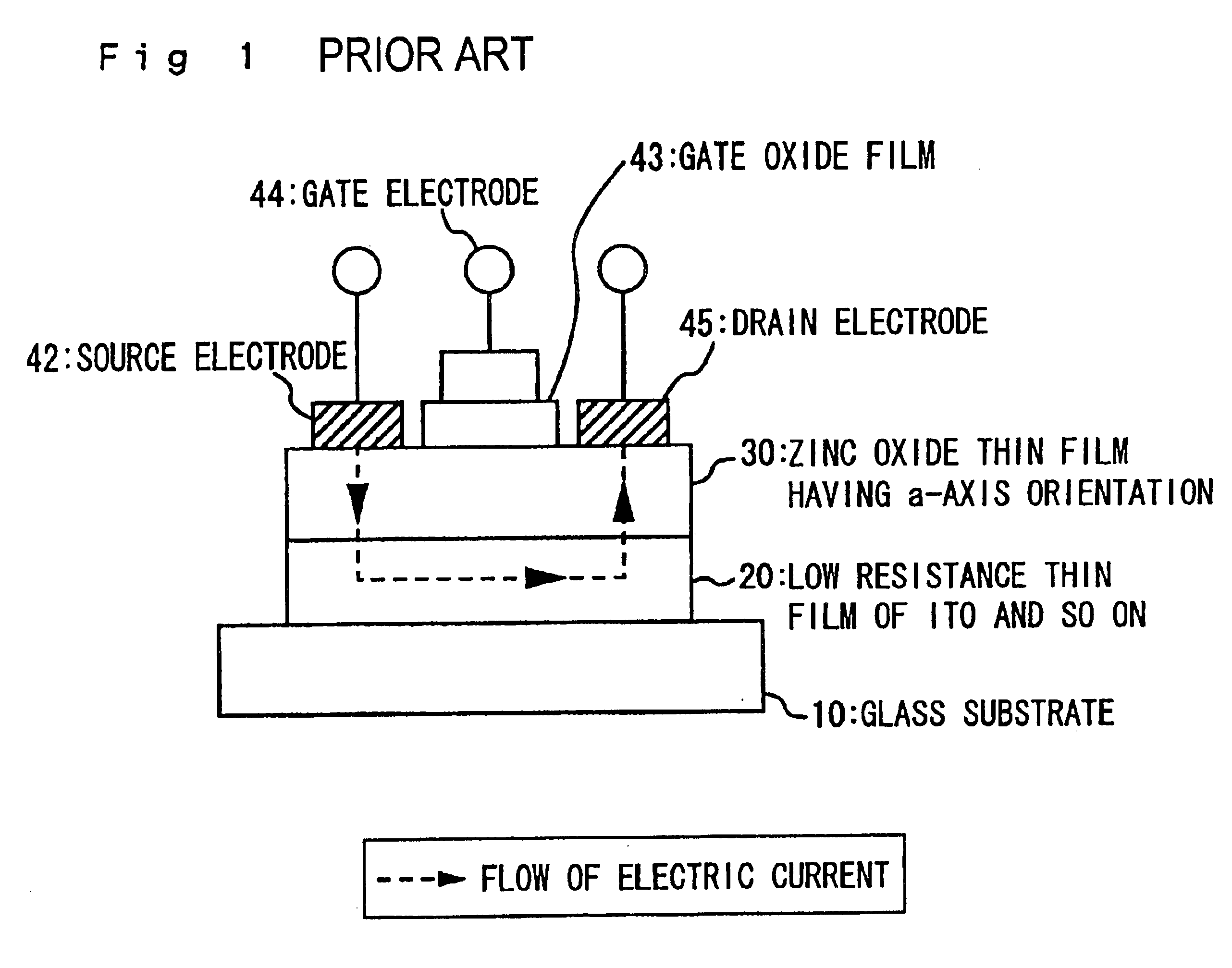Semiconductor polysilicon component and method of manufacture thereof
a polysilicon and semiconductor technology, applied in the direction of polycrystalline material growth, crystal growth process, chemically reactive gas growth, etc., can solve the problem of low resistivity comparable to that due insufficient resistivity, and inability to obtain a comparable resistivity to the mbe method, etc. problem, to achieve the effect of improving the reaction with an oxygen gas
- Summary
- Abstract
- Description
- Claims
- Application Information
AI Technical Summary
Benefits of technology
Problems solved by technology
Method used
Image
Examples
embodiment 1
(Embodiment 1)
In FIGS. 14A and 14B, an example in which the member is applied to a transparent transistor is shown. FIG. 14A is a sectional view of a transistor 310. The orientation of a used zinc oxide thin film is an a-axis that is an orientation axis best fitted to a flow of a current of the transparent transistor. A thickness of a first zinc oxide thin film 130 formed on a glass substrate 110 is in the range of 500 to 1,500 angstrom, and is preferable to be 1,000 angstrom. An n conductivity type is shown by diffusion of Al atoms from an Al thin film that is deposited at an interface and used to apply a DC bias. A film thickness of an oxide of Al after the oxidation of the metal Al is in the range of 200 to 400 angstrom. A film thickness of a second zinc oxide thin film 140 is in the range of 1,000 to 2,000 angstrom, and is preferable to be 1,500 angstrom. Li is added to the second zinc oxide thin film, and thereby zinc oxide showing a value of the resistivity of 106 Ω·cm is depo...
embodiment 2
(Embodiment 2)
The transparent transistor 310 shown in Embodiment 1 has the gate electrode in an upper portion thereof, in contrast, in a transistor 320 shown in Embodiment 2 of FIG. 14B, a gate electrode 326 is formed in a lower portion. The transistor 320 has features in that the transistor is less affected by an external circumstance and, since a member of the transistor is formed after a high quality gate insulating film is formed, the transistor is less influenced by the hysteresis due to a gate voltage fluctuation. All of the features and film thicknesses of the respective thin films become the same as that of Embodiment 1. The transparent transistor of this configuration allows further reducing an off-voltage than that of Embodiment 1.
embodiment 3
(Embodiment 3)
Embodiment 3 relates to a transparent transistor less affected by high temperatures and radiation. In a transistor made of Si or Ge, there is a problem in that, being narrow in a width of the forbidden band, owing to high temperatures or radiation, electrons in a filled band are excited to a conduction band, resulting in incapability of controlling by the gate voltage. The zinc oxide thin film has a width of the forbidden band of 3.2 eV that is twice as that of Si. Accordingly, the transistor that uses the zinc oxide thin film can be less affected by the high temperatures or radiation. However, when an oxide film of a material into which Al or Sn can easily diffuse is used, a metal component diffuses into zinc oxide, resulting in easily causing defects due to change of properties with time. Accordingly, as a structure of the transparent transistor that uses the zinc oxide thin film, though similar to that shown in FIGS. 14A and 14B, with an oxide film of tungsten (W) o...
PUM
| Property | Measurement | Unit |
|---|---|---|
| transmittance | aaaaa | aaaaa |
| thickness | aaaaa | aaaaa |
| transmittance | aaaaa | aaaaa |
Abstract
Description
Claims
Application Information
 Login to View More
Login to View More - R&D
- Intellectual Property
- Life Sciences
- Materials
- Tech Scout
- Unparalleled Data Quality
- Higher Quality Content
- 60% Fewer Hallucinations
Browse by: Latest US Patents, China's latest patents, Technical Efficacy Thesaurus, Application Domain, Technology Topic, Popular Technical Reports.
© 2025 PatSnap. All rights reserved.Legal|Privacy policy|Modern Slavery Act Transparency Statement|Sitemap|About US| Contact US: help@patsnap.com



